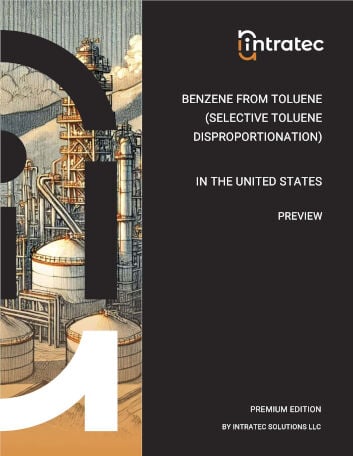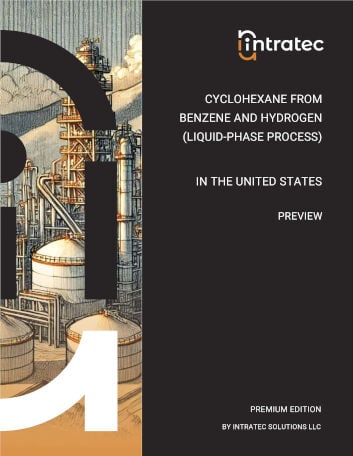Commodity Production Costs Report
Benzene from Toluene (Hydrodealkylation)
Benzene Plant Capital & Operating Cost Analysis | United States | Q3 2025
This report presents the economics of Benzene production from toluene. The process examined is similar to CB&I Lummus Detol technology for toluene hydrodealkylation.
The report provides a comprehensive study of Benzene production and related Benzene production cost, covering three key aspects: a complete description of the Benzene production process examined; an in-depth analysis of the related Benzene plant capital cost (Capex); and an evaluation of the respective Benzene plant operating costs (Opex).
The Benzene production process description includes a block flow diagram (BFD), an overview of the industrial site installations, detailing both the process unit and the necessary infrastructure, process consumption figures and comprehensive process flow diagrams (PFD). The Benzene plant capital cost analysis breaks down the Capex by plant cost (i.e., ISBL, OSBL and Contingency); owner's cost; working capital; and costs incurred during industrial plant commissioning and start-up. The Benzene plant operating costs analysis covers operating expenses, including variable costs like raw materials and utilities, and fixed costs such as maintenance, labor, and depreciation.

The process under analysis comprises three major sections: (1) Dealkylation; (2) Product Treatment; and (3) Hydrogen Recovery.
Dealkylation. Fresh toluene feed, recovered toluene from Benzene Column downstream and hydrogen recovered downstream, are mixed and fed to the Charge Heater, a fired heater where the mixture temperature is raised to the reaction temperature. The heated mixture is sent to two fixed bed reactors operating in series, where nonaromatic components are hydrocracked into light paraffins, and aromatics are dealkylated to benzene.
Product Treatment. In the stabilization area, the reactors effluent is partially condensed - the gaseous hydrogen-rich stream is routed to the Hydrogen Recovery section, while the liquid stream containing benzene is further treated for removal of remaining gas and low-boiling hydrocarbons. An aromatic hydrocarbons-rich stream is sent to the Benzene column. Benzene product is obtained from the top of the column, while toluene and heavier components withdrawn from the bottom are recycled to charged heater.
Hydrogen Recovery. The gaseous stream from the flash drum is mixed with make-up hydrogen and then fed to the bottom of an absorber column, to remove residual hydrocarbons and avoid build-up of impurities in the process. The washed hydrogen-rich gas is then compressed and recycled to the Charged Heater.
Report in PDF Format
Download & Explore Anytime
Access in Various Devices
Print & Read Comfortably
Share With Co-workers
Up-to-date Report
Professional report based on Q3 2025 economic data, ensuring timely evaluations.
Multiple Use Cases
Ideal for investment screening, feasibility studies, cost estimates, and research planning.
Proven Methodology
Developed using a consistent methodology honed over a decade, ensuring reliable cost analyses.
Report Editions
Content Highlights
Plant Capital Cost Summary
Summary outlining the capital cost required for building the Benzene production plant examined.
Plant Capital Cost Details
Detailing of fixed capital (ISBL, OSBL & Owner’s Cost), working capital and additional capital requirements.
Plant Cost Breakdowns
Breakdown of Benzene process unit (ISBL) costs and infrastructure (OSBL) costs; plant cost breakdown per discipline.
Operating Costs Summary
Summary presenting the operating variable costs and the total operating cost of the Benzene production plant studied.
Operating Cost Details
Detailing of utilities costs, operating fixed costs and depreciation.
Plant Capacity Assessment
Comparative analysis of capital investment and operating costs for different Benzene plant capacities.
Production Process Information
Block Flow Diagram, descriptions of process unit (ISBL) and site infrastructure (OSBL).
Process Consumptions
Raw materials and utilities consumption figures, by-products credits, labor requirements
Process Diagrams
Process flow diagrams (PFD), equipment list and industrial site configuration
Other Benzene Production Cost Reports

Benzene Production from Pygas (Hydrodealkylation Process)
This analysis presents the economics of Benzene production from pyrolysis gasoline (pygas) in the United States using a typical hydrodealkylation process. Initially, pygas is fractionated into 3 hydrocarbon cuts. The C6-C8 fraction is then directed to the hydrodealkylation step, in which the aromatics content in the process stream are converted into benzene
Details: 250 kta United States-based plant | Q3 2025 | 107 pages | Issue D | From $799 USD

Benzene Production from Light Oil
This study shows a techno-economic analysis of Benzene production from light oil using a hydrodealkylation process similar to Lummus Litol technology. The light oil feedstock used is a product from coal coking process. A C6-C8 fraction is separated. Then, diolefins and styrene are hydrogenated. The effluent is finally converted to benzene by hydrodealkylation. The plant is assumed to be located in the United States.
Details: 200 kta United States-based plant | Q3 2025 | 107 pages | Issue E | From $799 USD

Benzene from Toluene (Selective Toluene Disproportionation)
It presents the economics of a selective toluene disproportionation process (STDP) for Benzene production in the United States. In the STDP, toluene is converted into benzene and xylenes (mainly, p-xylene). The reaction is carried out with a zeolitic catalyst, in a hydrogen atmosphere to minimize coke formation and side reactions.
Details: 250 kta United States-based plant | Q3 2025 | 107 pages | Issue G | From $799 USD
Bundle & Save
Purchase multiple Benzene Production Cost reports and enjoy tiered discounts
up to 30% off!
Could Not Find the Report You Need?
Obtain a Bespoke Report
Get a report targeting the process in which you are interested
See Offer Details
Understand Bespoke Reports and how you can easily order them
Check Editions & Pricing
Complete a brief form and see a quotation for your Bespoke Report
Other Related Production Cost Reports

Toluene Production from Pygas
This study presents the economics of Toluene production from pyrolysis gasoline (pygas) in the United States using a typical liquid-liquid extraction process.
Details: 400 kta United States-based plant | Q3 2025 | 107 pages | Issue B | From $799 USD

Nitrobenzene Production from Benzene (NORAM)
This report presents the economics of Nitrobenzene production from benzene and nitric acid in the United States. The process analyzed in this report is similar to NORAM's adiabatic benzene nitration process, which uses a plug-flow nitrator containing jet-impingement elements.
Details: 530 kta United States-based plant | Q3 2025 | 107 pages | Issue A | From $799 USD

Cyclohexane from Benzene and Hydrogen (Liquid-Phase Process)
This feasibility study shows the economics of Cyclohexane production from benzene using a liquid phase hydrogenation process in the presence of a nickel-based catalyst. The economic analysis presented is based on a plant constructed in the United States.
Details: 200 kta United States-based plant | Q3 2025 | 107 pages | Issue A | From $799 USD

Toluene Production from Reformate
This report presents the economics of Toluene production from reformate. The reformate is submitted to a typical sulfolane liquid-liquid extraction, giving a mixture of aromatics, which is further processed to yield pure Toluene. Benzene and mixed xylenes are produced as by-products. The economic analysis presented is based on a plant constructed in the United States.
Details: 350 kta United States-based plant | Q3 2025 | 107 pages | Issue A | From $799 USD
+800 Reports Developed, Targeting +250 Commodities
Vast Report Library
858 independent and up-to-date reports examining embryonic and established production processes.
Free Sample Reports
Quickly understand the structure and depth of content of our professional reports.

